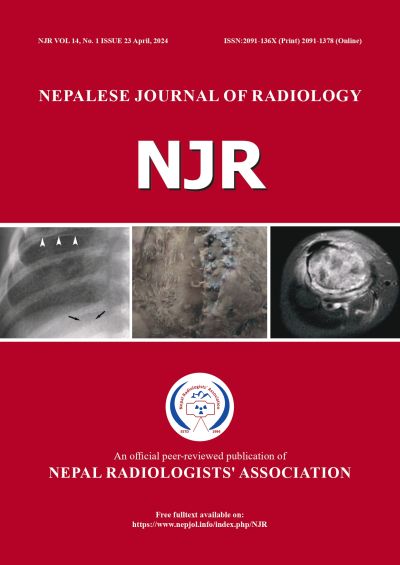Diffusion Tensor Tractography in Patient with Cervical Spondylosis and Correlation with Clinical Findings
DOI:
https://doi.org/10.3126/njr.v14i1.64623Keywords:
Anisotropy, Diffusion Tensor Imaging, Radiology, White MatterAbstract
Introduction: Diffusion tensor imaging is a non-invasive advanced method that provides information on white matter microstructural integrity. Fractional anisotropy and apparent diffusion coefficient have been used to quantify the degree of axonal damage and demyelination. The study aims to assess the role of diffusion tensor parameters in detecting early myelopathic changes and correlate them with clinical findings.
Methods: This cross-sectional prospective study including 60 patients with clinical history of cervical myelopathy was carried out at the Department of Radiology from June 2021 to July 2022. Nurick score was used to assess the severity clinically and diffusion tensor images of the cervical spine were obtained using 3 Tesla MRI. These diffusion tensor values at the level of maximum stenosis were compared with those of the non-stenotic level. A correlation between the diffusion tensor parameters and clinical Nurick score was done.
Results: The fractional anisotropy values were significantly lower (0.51 ± 0.14 vs 0.76 ± 0.47) and apparent diffusion coefficient values were significantly higher (1.20 ± 0.20 vs 1.04 ± 0.12) at the level of maximum stenosis compared with non-stenotic levels. There was a moderate positive and strong negative correlation between the apparent diffusion coefficient and fractional anisotropy values with the Nurick score.
Conclusions: A significant reduction in the fractional anisotropy and an increase in apparent diffusion coefficient values at the level of stenosis was observed in individuals without a high T2 signal within the cord. Thus, these parameters might have a potential role in the early diagnosis of cervical spondylotic myelopathy
Downloads
Downloads
Published
How to Cite
Issue
Section
License
Copyright (c) 2024 Nepalese Journal of Radiology

This work is licensed under a Creative Commons Attribution-NonCommercial 4.0 International License.
This license enables reusers to distribute, remix, adapt, and build upon the material in any medium or format, so long as attribution is given to the creator. The license allows for commercial use.




